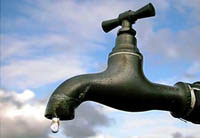
Their challenge is to wring water from the air more efficiently while also purifying it for drinking. Some use older technologies similar to those found in a dehumidifier and others have developed new proprietary methods for producing water even in the driest conditions.
Element Four, a Canadian firm, has created the WaterMill for household use. It draws air through a filter and cools it until water condenses. The water then passes through another filter and is exposed to ultraviolet light to kill bacteria. The WaterMill weighs about 45 pounds, runs on electricity, and can produce as much as 13 quarts of water per day. It sells for $1,300. The company is also designing a similar product for humanitarian agencies to use in remote locations. The WaterWall will have the capacity to serve an entire village and be able to run on alternative energy sources such as photovoltaic panels as well as car batteries. Rick Howard, CEO of Element Four, is optimistic about quenching the world’s thirst. He says it is one of his company’s core principles—“to do good as we do well.”
Aqua Sciences of Miami Beach has one of the most unique water technologies. It is manufacturing 40-foot-long mobile units that can produce 350 to 1,200 gallons of potable water a day. The model for this technology is the lowly salt shaker that clogs in humid climates. Using hydroscopic salts, the machine attracts water molecules from the air, and then extracts the water from the solution. The salts also act as a natural decontaminant. While machines that rely on condensation may need humidity of 30 percent, the Aqua Sciences machines require only 14 percent humidity.
The Federal Emergency Management Agency in Florida has purchased two of the machines for a test run, and the U.S. Army is using the mobile units in Iraq. Until now, the army has transported bottled water on C-17 cargo planes and then trucked it to the troops. By plane, the cost is $30 per gallon; from the mobile unit in the field, it is 30 cents per gallon. If the Aqua Sciences machines become standard army equipment, the savings could amount to billions of dollars.
For more information visit www.elementfour.com


